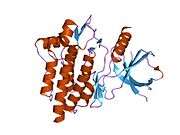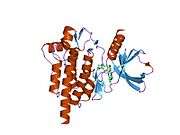Syk
| View/Edit Human | View/Edit Mouse |
Spleen tyrosine kinase, also known as Syk, is an enzyme which in humans is encoded by the SYK gene.[4][5][6]
Function
SYK, along with Zap-70, is a member of the Syk family of tyrosine kinases. These non-receptor cytoplasmic tyrosine kinases share a characteristic dual SH2 domain separated by a linker domain.[7]
While Syk and Zap-70 are primarily expressed in hematopoietic tissues, there is expression of Syk in a variety of tissues. Within B and T cells respectively, Syk and Zap-70 transmit signals from the B-Cell receptor and T-Cell receptor.[7] Syk plays a similar role in transmitting signals from a variety of cell surface receptors including CD74, Fc Receptor, and integrins.
Function during development
Mice that lack Syk completely (Syk−/−, Syk-knockout) die during embryonic development around midgestation. They show severe defects in the development of the lymphatic system. Normally, the lymphatic system and the blood system are strictly separated from each other. However, in Syk deficient mice the lymphatics and the blood vessels form abnormal shunts, leading to leakage of blood into the lymphatic system. The reason for this phenotype was identified by a genetic fate mapping approach, showing that Syk is expressed in myeloid cells which orchestrate the proper separation of lymphatics and blood system during embryogenesis and beyond. Thus, Syk is an essential regulator of the lymphatic system development in mice.[8]
Clinical significance
Abnormal function of Syk has been implicated in several instances of hematopoeitic malignancies including translocations involving Itk and Tel. Constitutive Syk activity can transform B cells.[7] Several transforming viruses contain "Immunoreceptor Tyrosine Activation Motifs" (ITAMs) which lead to activation of Syk including Epstein Barr virus, bovine leukemia virus, and mouse mammary tumor virus.
SYK inhibition
Given the central role of SYK in transmission of activating signals within B-cells, a suppression of this tyrosine kinase might aid in the treatment of B cell malignancies and autoimmune diseases.[9] This has been demonstrated by the orally active inhibitor fostamatinib (R788) in the treatment of rheumatoid arthritis.[10] The 6-month double-blind, placebo-controlled trial investigated clinical responses in 457 patients with rheumatoid arthritis who were not sufficiently responsive to methotrexate. The drug indeed caused a dose-dependent improvement in disease severity. The drug was however associated with an increase in the frequency in diarrhea, upper respiratory tract infections, neutropenia. Moreover, R788 increased blood pressure and a concomitant increase in treatment with antihypertensive drugs. The drug is investigational and at present the final position within the broad set of antirheumatic drugs and its long-term safety are unknown.
SYK inhibition is also been studied in Alzheimer's disease. it is believed that suppressing this protein may reduce all the 3 pathologies namely amyloid beta, tau and neuroinflamation. A drug called Nilvadipine is currently in phase 3 trials for the treatment of Alzheimer's disease.
Syk inhibition has also been proposed as a therapy for both lymphoma and chronic lymphocytic leukemia.<[7] Other inhibitors of B-cell receptor (BCR) signaling including ibrutinib (PCI-32765) which inhibits BTK, and idelalisib (PI3K inhibitor - CAL-101 / GS-1101) showed activity in the diseases as well. Newer Syk inhibitors have entered the clinic and are also in clinical development (GS-9973).[9] now named entospletinib.[11][12]
Epithelial malignancies
The role of Syk in epithelial malignancies is controversial. Several authors have suggested that abnormal Syk function facilitates transformation in Nasopharyngeal carcinoma and head and neck cancer while other authors have suggested a tumor suppressor role in breast and gastric cancer.
Without Syk, the protein it makes, and genetic disruption in a panel of 55 genes thought also to be controlled by Syk, breast ductal carcinoma in situ (breast DCIS, which can become invasive), it is believed that the cancer has a markedly increased tendency to invade and metastasize.[13]
Interactions
Syk has been shown to interact with:
- Cbl gene[14][15][16]
- CRKL,[17]
- FCGR2A,[18][19]
- FYN,[20][21]
- Grb2,[22][23]
- Lck,[24]
- LYN,[25]
- PTK2,[26]
- PTPN6,[22][27] and
- VAV1.[14][28][29]
References
- ↑ "Diseases that are genetically associated with SYK view/edit references on wikidata".
- ↑ "Human PubMed Reference:".
- ↑ "Mouse PubMed Reference:".
- ↑ "Entrez Gene: SYK Spleen tyrosine kinase".
- ↑ Chan AC, Iwashima M, Turck CW, Weiss A (November 1992). "ZAP-70: a 70 kd protein-tyrosine kinase that associates with the TCR zeta chain". Cell. 71 (4): 649–62. doi:10.1016/0092-8674(92)90598-7. PMID 1423621.
- ↑ Ku G, Malissen B, Mattei MG (1994). "Chromosomal location of the Syk and ZAP-70 tyrosine kinase genes in mice and humans". Immunogenetics. 40 (4): 300–2. doi:10.1007/BF00189976. PMID 8082894.
- 1 2 3 4 Seda, V; Mraz, M (2014). "B cell receptor (BCR) signalling and its crosstalk with other pathways in normal and malignant cells". European Journal of Haematology: n/a. doi:10.1111/ejh.12427. PMID 25080849.
- ↑ Böhmer R; Neuhaus B; Bühren S; Zhang D; Stehling S; Böck B; Friedemann Kiefer (2010). "Regulation of Developmental Lymphangiogenesis by Syk+ Leukocytes". Dev. Cell. 18 (3): 437–49. doi:10.1016/j.devcel.2010.01.009. PMID 20230750.
- 1 2 Seda, V; Mraz, M (2014). "B cell receptor (BCR) signalling and its crosstalk with other pathways in normal and malignant cells". European Journal of Haematology: n/a. doi:10.1111/ejh.12427. PMID 25080849.
- ↑ Weinblatt ME, Kavanaugh A, Genovese MC, Musser TK, Grossbard EB, Magilavy DB (September 2010). "An oral spleen tyrosine kinase (Syk) inhibitor for rheumatoid arthritis.". N Engl J Med. 363 (14): 1303–12. doi:10.1056/NEJMoa1000500. PMID 20879879.
- ↑ An open-label phase 2 trial of entospletinib (GS-9973), a selective spleen tyrosine kinase inhibitor, in chronic lymphocytic leukemia.
- ↑ Novel BTK, PI3K Inhibitors on Horizon for Relapsed CLL. March 2016
- ↑ http://explore.georgetown.edu/news/?ID=74635&PageTemplateID=295
- 1 2 Bertagnolo V, Marchisio M, Brugnoli F, Bavelloni A, Boccafogli L, Colamussi ML, Capitani S (April 2001). "Requirement of tyrosine-phosphorylated Vav for morphological differentiation of all-trans-retinoic acid-treated HL-60 cells". Cell Growth Differ. 12 (4): 193–200. PMID 11331248.
- ↑ Lupher ML, Rao N, Lill NL, Andoniou CE, Miyake S, Clark EA, Druker B, Band H (December 1998). "Cbl-mediated negative regulation of the Syk tyrosine kinase. A critical role for Cbl phosphotyrosine-binding domain binding to Syk phosphotyrosine 323". J. Biol. Chem. 273 (52): 35273–81. doi:10.1074/jbc.273.52.35273. PMID 9857068.
- ↑ Melander F, Andersson T, Dib K (March 2003). "Fgr but not Syk tyrosine kinase is a target for beta 2 integrin-induced c-Cbl-mediated ubiquitination in adherent human neutrophils". Biochem. J. 370 (Pt 2): 687–94. doi:10.1042/BJ20021201. PMC 1223185
 . PMID 12435267.
. PMID 12435267. - ↑ Oda A, Ochs HD, Lasky LA, Spencer S, Ozaki K, Fujihara M, Handa M, Ikebuchi K, Ikeda H (May 2001). "CrkL is an adapter for Wiskott-Aldrich syndrome protein and Syk". Blood. 97 (9): 2633–9. doi:10.1182/blood.V97.9.2633. PMID 11313252.
- ↑ Ibarrola I, Vossebeld PJ, Homburg CH, Thelen M, Roos D, Verhoeven AJ (July 1997). "Influence of tyrosine phosphorylation on protein interaction with FcgammaRIIa". Biochim. Biophys. Acta. 1357 (3): 348–58. doi:10.1016/S0167-4889(97)00034-7. PMID 9268059.
- ↑ Kim MK, Pan XQ, Huang ZY, Hunter S, Hwang PH, Indik ZK, Schreiber AD (January 2001). "Fc gamma receptors differ in their structural requirements for interaction with the tyrosine kinase Syk in the initial steps of signaling for phagocytosis". Clin. Immunol. 98 (1): 125–32. doi:10.1006/clim.2000.4955. PMID 11141335.
- ↑ Deckert M, Elly C, Altman A, Liu YC (April 1998). "Coordinated regulation of the tyrosine phosphorylation of Cbl by Fyn and Syk tyrosine kinases". J. Biol. Chem. 273 (15): 8867–74. doi:10.1074/jbc.273.15.8867. PMID 9535867.
- ↑ Chung J, Gao AG, Frazier WA (June 1997). "Thrombspondin acts via integrin-associated protein to activate the platelet integrin alphaIIbbeta3". J. Biol. Chem. 272 (23): 14740–6. doi:10.1074/jbc.272.23.14740. PMID 9169439.
- 1 2 Ganju RK, Brubaker SA, Chernock RD, Avraham S, Groopman JE (June 2000). "Beta-chemokine receptor CCR5 signals through SHP1, SHP2, and Syk". J. Biol. Chem. 275 (23): 17263–8. doi:10.1074/jbc.M000689200. PMID 10747947.
- ↑ Saci A, Liu WQ, Vidal M, Garbay C, Rendu F, Bachelot-Loza C (May 2002). "Differential effect of the inhibition of Grb2-SH3 interactions in platelet activation induced by thrombin and by Fc receptor engagement". Biochem. J. 363 (Pt 3): 717–25. doi:10.1042/0264-6021:3630717. PMC 1222524
 . PMID 11964172.
. PMID 11964172. - ↑ Thome M, Duplay P, Guttinger M, Acuto O (June 1995). "Syk and ZAP-70 mediate recruitment of p56lck/CD4 to the activated T cell receptor/CD3/zeta complex". J. Exp. Med. 181 (6): 1997–2006. doi:10.1084/jem.181.6.1997. PMC 2192070
 . PMID 7539035.
. PMID 7539035. - ↑ Sidorenko SP, Law CL, Chandran KA, Clark EA (January 1995). "Human spleen tyrosine kinase p72Syk associates with the Src-family kinase p53/56Lyn and a 120-kDa phosphoprotein". Proc. Natl. Acad. Sci. U.S.A. 92 (2): 359–63. doi:10.1073/pnas.92.2.359. PMC 42739
 . PMID 7831290.
. PMID 7831290. - ↑ Sada K, Minami Y, Yamamura H (September 1997). "Relocation of Syk protein-tyrosine kinase to the actin filament network and subsequent association with Fak". Eur. J. Biochem. 248 (3): 827–33. doi:10.1111/j.1432-1033.1997.00827.x. PMID 9342235.
- ↑ Dustin LB, Plas DR, Wong J, Hu YT, Soto C, Chan AC, Thomas ML (March 1999). "Expression of dominant-negative src-homology domain 2-containing protein tyrosine phosphatase-1 results in increased Syk tyrosine kinase activity and B cell activation". J. Immunol. 162 (5): 2717–24. PMID 10072516.
- ↑ Deckert M, Tartare-Deckert S, Couture C, Mustelin T, Altman A (December 1996). "Functional and physical interactions of Syk family kinases with the Vav proto-oncogene product". Immunity. 5 (6): 591–604. doi:10.1016/S1074-7613(00)80273-3. PMID 8986718.
- ↑ Song JS, Gomez J, Stancato LF, Rivera J (October 1996). "Association of a p95 Vav-containing signaling complex with the FcepsilonRI gamma chain in the RBL-2H3 mast cell line. Evidence for a constitutive in vivo association of Vav with Grb2, Raf-1, and ERK2 in an active complex". J. Biol. Chem. 271 (43): 26962–70. doi:10.1074/jbc.271.43.26962. PMID 8900182.
Further reading
- Turner M, Schweighoffer E, Colucci F, et al. (2000). "Tyrosine kinase SYK: essential functions for immunoreceptor signalling". Immunol. Today. 21 (3): 148–54. doi:10.1016/S0167-5699(99)01574-1. PMID 10689303.
- Fruman DA, Satterthwaite AB, Witte ON (2000). "Xid-like phenotypes: a B cell signalosome takes shape". Immunity. 13 (1): 1–3. doi:10.1016/S1074-7613(00)00002-9. PMID 10933389.
- Yanagi S, Inatome R, Takano T, Yamamura H (2001). "Syk expression and novel function in a wide variety of tissues". Biochem. Biophys. Res. Commun. 288 (3): 495–8. doi:10.1006/bbrc.2001.5788. PMID 11676469.
- Tohyama Y, Yamamura H (2006). "Complement-mediated phagocytosis--the role of Syk". IUBMB Life. 58 (5–6): 304–8. doi:10.1080/15216540600746377. PMID 16754322.
- Schymeinsky J, Mócsai A, Walzog B (2007). "Neutrophil activation via beta2 integrins (CD11/CD18): molecular mechanisms and clinical implications". Thromb. Haemost. 98 (2): 262–73. doi:10.1160/th07-02-0156. PMID 17721605.
External links
- Syk kinase at the US National Library of Medicine Medical Subject Headings (MeSH)








